2010 Moscow Victory Day Parade

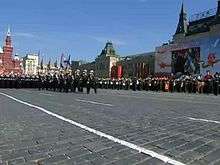
The Moscow Victory Day Parade of 2010 was held on 9 May 2010 to commemorate the 65th anniversary of the capitulation of Nazi Germany in 1945. The parade marks the Soviet Union's victory in the Great Patriotic War.
It was the largest parade held in Moscow, Russia since the Soviet Union's dissolution in 1991, and saw 11,135 troops, 127 aircraft and helicopters, and the new Topol-M mobile intercontinental ballistic missile taking part. For the first time, the 2010 parade also included military units from foreign countries who were allied with the Soviet Union during World War II, with representation from France, Poland, the United Kingdom, the United States and members of the Commonwealth of Independent States.
Military components
The 9 May Victory Day Parade in Moscow involved more than 10,000 troops marching, 160 military vehicles and 127 military aircraft, making it the largest parade to be held since the dissolution of the Soviet Union in 1991.[1]
Twenty aviation groups of the Russian Air Force took part in the parade, which saw the Ilyushin Il-76, Ilyushin Il-78, Antonov An-124, Sukhoi Su-27, Ilyushin Il-80, Beriev A-50, Tupolev Tu-22M, Sukhoi Su-25, Mikoyan MiG-29, Mikoyan MiG-31, Tupolev Tu-95 and Tupolev Tu-160 performing flypasts. Also taking part for the first time were the Yakovlev Yak-130 jet trainer aircraft and the Mil Mi-26 heavy helicopter.[2] The mobile ICBM Topol-M missile, that first appeared at the 2009 parade, was shown here again for the second consecutive year .[3]
Foreign military

The 2010 Parade marked the first time that foreign and Commonwealth of Independent States (CIS) soldiers joined Russian forces on Red Square for the parade.[1][4] Battalions from the CIS included Armenia, Azerbaijan, Belarus, Kazakhstan, Kyrgyzstan, Moldova, Tajikistan and Ukraine among them. Upon request from the government of Turkmenistan, the contingent from Turkmenistan was led by an officer riding on horseback, with the horse being flown into Moscow from Ashgabat.[5] Poland was represented by the Representative Battalion of the Polish Armed Forces.[5] The United Kingdom was represented by a detachment of 76 soldiers from Number 2 Company, 1st Battalion, Welsh Guards, the Central Band of the Royal Air Force and the Band of the Royal Air Force Regiment.[1] The United States was represented by the 2nd Battalion of the 18th Infantry Regiment and the Naval Forces Europe Band. France was represented by pilots and aircraft from the Normandie-Niemen Air Regiment. Russian President Dmitry Medvedev called the inclusion of foreign troops in the parade recognition of their "common victory" in World War II.[6]
The inclusion of foreign troops in the parade was not without controversy. The Communist Party of the Russian Federation held a May Day rally in Moscow, at which several thousand protesters used the rally to decry the inclusion of troops from NATO countries in the parade.[7] A poll run by the Levada Center saw 20 percent of respondents disapproving of the presence of foreign troops, with 8 percent being strongly opposed.[6]
International dignitaries

Mihai Ghimpu, the Acting President of Moldova, stated in late April 2010, after previously accepting an invitation from Russian President Dmitry Medvedev to attend the celebrations, that he would not be attending, claiming "I have no ties with Moscow. Only the victorious are going, what will the defeated do there?" Concerns also arose that a Moldovan contingent would not be able to attend the parade because of financial difficulties in the country, but a Moldovan government source told Kommersant that this was only an excuse, and Ghimpu was choosing to improve Moldova's relations with Romania, which was not invited to attend the celebrations as it was an ally of Germany during World War II.[8] Russian Foreign Minister Sergey Lavrov responded to remarks by Ghimpu, which also included the opinion that Russia should pay Moldova compensation for what he claimed was a "Soviet occupation", by urging Moldovan authorities not to use the occasion for political speculation.[9] King Michael of Romania, one of the last heads of state alive from World War II, was invited by Russian president Medvedev to attend the ceremony.[10]
German Chancellor Angela Merkel confirmed her attendance on 30 April,[11] as did Acting President of Poland Bronisław Komorowski.[12] Komorowski's attendance is said to be part of an effort to bolster Poland–Russia relations, which improved after the death of Polish President Lech Kaczyński in a plane crash near Smolensk in early April 2010.[12] Kaczyński is said to have confirmed his attendance at the parade shortly prior to the crash in which he was killed,[12] with reports in the week prior to his death showing that he was questioning his attendance.[13]
Chinese President Hu Jintao confirmed his attendance at the parade on 3 May.[14] The following day Slovak President Ivan Gašparovič's attendance was confirmed.[15] Other world leaders who confirmed their attendance included Czech President Václav Klaus,[16] French President Nicolas Sarkozy,[16] Italian Prime Minister Silvio Berlusconi,[16] Serbian President Boris Tadić,[17] Bulgarian President Georgi Parvanov,[18] and Vietnamese President Nguyễn Minh Triết,[19] Leaders from Armenia, Azerbaijan, Estonia, Greece, Israel, Kazakhstan, Latvia, Mongolia and Slovenia also confirmed their attendance.[8][17] On 8 May Sarkozy and Berlusconi announced that they wouldn't be attending the parade in Moscow, so that they could tackle the European sovereign debt crisis.[20][21]
Both the United Kingdom and the United States had planned to send high-profile representatives. Gordon Brown, the Prime Minister of the United Kingdom, was invited to Russia, but because of the UK general election he was unable to attend; the Foreign and Commonwealth Office suggested Charles, Prince of Wales, instead. Barack Obama, the President of the United States, was also unable to attend, but offered Vice President Joe Biden as the US representative; Biden was in Brussels as part of US efforts to improve relations with the European Union.[22][23] According to The Guardian, both figures were rejected by Russian Prime Minister Vladimir Putin, however, in what both countries perceived as a diplomatic snub. This was put down to poor British relations with Russia over the UK's continuing refusal to extradite Boris Berezovsky over Russian charges of embezzlement, and because of Biden's close relations with Georgian President Mikheil Saakashvili, who is widely unpopular in Russia because of the 2008 Russia–Georgia War. The UK and US were instead represented by their ambassadors to Russia, Dame Anne Pringle and John Beyrle respectively.[23]
The list of heads of foreign states, governments and international organisations that attended the parade were:[24]
The parade

At 10:00am (MSK), the clock of Spasskaya Tower in the Moscow Kremlin rang and signalled the beginning of the parade commemorating the defeat of Nazi Germany by the Union of Soviet Socialist Republics in the Great Patriotic War. The event then began with the display of the flag of Russia and the Victory Banner. After this, commander of the Moscow Military District Colonel General Valery Gerasimov, who commanded the parade, and Anatoly Serdyukov, the Russian Minister of Defence, who inspected the parade, joined and inspected the troops. At 10:14am, Serdyukov reported to Supreme Commander-in-Chief, and Russian President, Dmitry Medvedev on the readiness of the troops.[25]
After this President Medvedev made a speech in which he stated, "Sixty-five years ago Nazism was vanquished. The machine that was wiping out whole nations was stopped. Peace returned to our country and to Europe as a whole. An end was put to the ideology that was destroying the fundamentals of civilisation." Medvedev also emphasised the role the Soviet Union played in the war, bearing the brunt of Nazi attacks, in which some three-quarters of their military forces participated.[25][26]
After his speech and the playing of the National Anthem of the Russian Federation, a parade of troops took place on Red Square, led by the Drummers' Company of the Moscow Military Conservatoire, Military University of the MDRF. Some 10,500 thousand troops marched, and approximately 1,000 troops from the Commonwealth of Independent States, Poland, the United Kingdom, France and the United States also marched. This was followed by a procession of 161 pieces of military hardware through Red Square, and 127 aircraft and helicopters making a flypast over the Kremlin to form the number "65".[25]
The historical part of the parade began with the entry onto Red Square of infantry, air force and navy representatives in uniforms resplendent of the Great Patriotic War. Behind them troops from Armenia, Azerbaijan, Belarus, Kazakhstan, Kyrgyzstan, Moldova, Tajikistan and Ukraine marched. Each of these nations of the Commonwealth of Independent States were represented by some 70 troops. Following the participants from the CIS, was a guard of honour from the Polish Army, and they were followed by 71 members of the British Army, 76 members of the United States military, and 68 members of the French military. At the rear of the foreign segment of the parade were 68 troops from Turkmenistan, led by a commander riding on horseback, of which the horse has blood-lines to the horse lent to Marshal Georgy Zhukov by Stalin for the original parade.[25] It was followed by the Presidential Regiment Cavalry Escort Squadron, wearing GPW uniforms of the Soviet Cavalry forces.
Parade Participants
Note: Those indicated in bold indicate first parade appearance, those indicated with italic indicate double or multiple parade appearances.
- Colonel General Valery Gerasimov, Commander of the Moscow Military District (parade commander)
- Defense Minister of the Russian Federation Anatoliy Serdyukov (parade inspector)
Military Bands in Attendance
- Massed Military Bands led and conducted by Major General Valery Khalilov and composed of:
- Headquarters Band of the Moscow Military District under Lt. Col. V Shevernev
- Central Military Band of the MDRF under Col. Andrei Kolotushkin and Drum Major of the Central Band Lt. Col. Sergey Durygin
- Headquarters Band, of the Ministry of Internal Affairs of the Russian Federation
- Central Band of the Russian Navy
- Band of the Moscow Military Conservatoire, Military University of the Ministry of Defense of the Russian Federation
- HQ Band of the Ministry of Emergency Situations of the Russian Federation
- Band of the Combined Arms Academy of the Armed Forces of the Russian Federation
- Band of the Military Technological University
- Band of the Peter the Great Military Academy of the Rocket Forces of Strategic Importance
- Central Band of the Royal Air Force
- The Band of the Royal Air Force Regiment
- United States Navy Naval Forces Europe Band
- Wind and Fanfare Band of the French Army Ile-de-France Military Region
- Band of the 5th Tamanskaya Guards Ind. Motor Rifle Brigade "Mikhail Kalinin"
- Band of the 4th Kantemir Guards Armored Brigade "Yuri Andropov"
- Band of the 25th Sevastopol Guards Motor Rifle Brigade
- Central Band of the Russian Air Force
- Band of the Gagarin-Zhukovsky Combined Air Force Academy
- Headquarters Band of the Russian Airborne Forces
- Band of the Ryazan Airborne Command Academy
- Headquarters Band of the Federal Security Service
- Band of the MES Civil Defense Academy
- Moscow Combined Band of the Ministry of Internal Affairs
- Drummers Company, Moscow Military Conservatoire, Military University of the Ministry of Defense of the Russian Federation
Ground Column
- 154th Moscow Garrison Commandant's Honor Guard Regiment and Color Guards
- Colors Party composed of:
- Combined Honor Guards Company of the Armed Forces
- Historical troops and colors
- Front Standard bearers
- Historical Colors Party
- Historical troops of the Soviet Armed Forces
- Red Army
- Soviet Air Forces
- Soviet Navy
- WPRA Army Cavalry Corps and Cavalry Mechanized Groups Command (represented by the Cavalry Escort Squadron of the Presidential Regiment)
- Forces of the Commonwealth of Independent States and Allied nations
- Armed Forces of Azerbaijan
- Armed Forces of Armenia
- Special Forces Regiment of the Belarusian Army
- Honor Guard of the Republic of Kazakhstan Army
- Armed Forces of the Republic of Kyrgyzstan
- Honor Guard Company of the Moldovan Army
- Military Institute of the Ministry of Defense of Tajikistan
- Ukrainian Ground Forces Military Academy
- Composite Honor Guards Battalion of the Polish Armed Forces
- 2nd Coy. 1st Battalion, Welsh Guards, British Army
- 18th_Infantry_Regiment_(United_States), United States Army
- Normandie-Niemen Air Regiment, French Air Force
- Honor Guard of the Armed Forces of Turkmenistan
- Armed Forces of the Russian Federation, Ministry of Internal Affairs of the Russian Federation, Ministry of Emergency Situations and Civil Defense of the Russian Federation, Federal Security Service of the Russian Federation
- Combined Arms Academy of the Armed Forces of the Russian Federation
- Military University of the Ministry of Defense of the Russian Federation
- Gagarin-Zhukovsky Combined Air Force Academy
- Air Force Gen. Staff School of Rocket Forces and Anti-Air Defense Training
- Baltic Naval Military Institute "Admiral Fyodor Ushakov"
- 336th Separate Bialystok Guards Naval Infantry Brigade of the Baltic Fleet
- Peter the Great Military Academy of the Rocket Forces of Strategic Importance
- Moscow Military Rocket Forces Institute, SRFI RF
- Military Space Academy
- Moscow Military Space Institute of Radio Electronics
- Ryazan Airborne Command Academy "Gen. of the Army Vasily Margelov"
- 331st Guards Airborne Regiment
- Moscow Border Service Institute of the Federal Security Service
- OMSDON 1st Internal Troops Division of the Ministry of Internal Affairs of the Russian Federation "Felix Dzenzhinsky"
- Civil Defense Academy of the Ministry of Emergency Situations of the Russian Federation
- Military Technological University
- 5th Tamanskaya Guards Ind. Motor Rifle Brigade "Mikhail Kalinin"
- 25th Sevastopol Guards Motor Rifle Brigade
- Moscow Military Commanders Training School "Supreme Soviet of the RSFSR/Russian Federation"
Mobile Column
- T-34
- GAZ-67B
- SU-100
- GAZ-2975
- BPM-97
- BTR-80
- BMP-3
- T-90
- 2S19 Msta
- Buk missile system
- TOS-1
- BM-30 Smerch
- S-400 Triumf
- Pantsir-S1
- Iskander-M
- Topol-M
Air Column Flypast

- Mi-8 Colors Party
- Mi-24
- Mi-28
- Mil Mi-35
- Yak-130
- MiG-29
- Sukhoi Su-24
- Sukhoi Su-34
- Sukhoi Su-27
- Tu-22M3
- Tu-95
- Tu-160
- Joint formation squadron of Russian Knights and Strizhi (Sukhoi Su-27 and Mikoyan MiG-29)
- Il-78
- Beriev A-50
- Sukhoi Su-25
- Antonov An-124
Gallery
-

Honour guard marching with the Russian flag and the Victory Banner
-

President Dmitry Medvedev making a speech
-
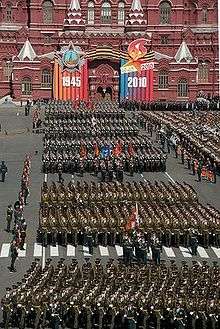
Overview of troops taking part in the parade
-

Soldiers of the Armed Forces of the Russian Federation
-

Contingent from the Azerbaijani military
-

Contingent from the Armenian military
-

Contingent from the Polish military
-
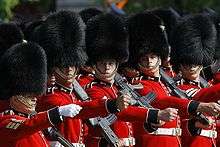
Welsh Guards from the British military
-

Contingent from the United States Army's 18th Infantry Regiment
-

Contingent from the Turkmen military
-

Military vehicles on the Red Square
-

S-400 on the parade
-

Aircraft from the Russian Air Force and the Coat of Arms of Russia
-

Russian Knights and Strizhi over the Red Square
-

Russian flag presented by Su-25s
-
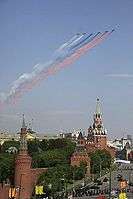
The sky over the Moscow Kremlin
-

State leaders during the ceremony of laying wreaths to the Tomb of the Unknown Soldier
-

Fireworks at the Moscow Kremlin on the night of 9 May
References
- 1 2 3 Osborn, Andrew (28 April 2010). "Russia prepares spectacular Red Square parade". Moscow: The Daily Telegraph. Archived from the original on 1 May 2010. Retrieved 4 May 2010.
- ↑ "Russia's Air Force rehearses for Victory Day parade over Moscow". Moscow: RIA Novosti. 4 May 2010. Archived from the original on 6 May 2010. Retrieved 4 May 2010.
- ↑ "Topol M missiles to be shown at Victory Day parade on Moscow's Red Square". Moscow: RIA Novosti. 26 February 2010. Archived from the original on 5 May 2010. Retrieved 5 May 2010.
- ↑ "Another rehearsal for Victory Parade in Red Square". Voice of Russia. 3 May 2010. Retrieved 4 May 2010.
- 1 2 "Victory parade – a move to the future". Voice of Russia. 28 April 2010. Archived from the original on 29 April 2010. Retrieved 4 May 2010.
- 1 2 "Western troops join Russia's Victory Day parade". Moscow: CNN. 9 May 2010. Archived from the original on 9 May 2010. Retrieved 9 May 2010.
- ↑ "Russian Communists use May Day to protest NATO role in WWII parade". Moscow: RIA Novosti. 1 May 2010. Retrieved 4 May 2010.
- 1 2 "Acting Moldovan president says will not attend Moscow Victory Day celebrations — paper". Moscow: RIA Novosti. 26 April 2010. Archived from the original on 29 April 2010. Retrieved 4 May 2010.
- ↑ "Moscow irate over Moldovan president's WWII remarks". Strasbourg: RIA Novosti. 28 April 2010. Archived from the original on 2 May 2010. Retrieved 4 May 2010.
- ↑ http://www.familiaregala.ro/news/1537/53/Regele-Mihai-la-Moscova/
- ↑ "Germany's Merkel to attend V-Day celebrations in Moscow". Berlin: RIA Novosti. 30 April 2010. Archived from the original on 4 May 2010. Retrieved 4 May 2010.
- 1 2 3 "Top Polish politician heads to Moscow parade to cement ties". Moscow: RIA Novosti. 30 April 2010. Archived from the original on 1 May 2010. Retrieved 4 May 2010.
- ↑ "Kaczynski questions his participation in Moscow Victory Day". Warsaw: RIA Novosti. 1 April 2010. Archived from the original on 4 April 2010. Retrieved 4 May 2010.
- ↑ "China's Hu to visit Moscow for Victory Day celebrations". Beijing: RIA Novosti. 3 May 2010. Archived from the original on 6 May 2010. Retrieved 4 May 2010.
- ↑ "Slovak president to visit Moscow for May 9". Voice of Russia. 4 May 2010. Archived from the original on 5 May 2010. Retrieved 4 May 2010.
- 1 2 3 "Press review". Voice of Russia. 4 May 2010. Archived from the original on 5 May 2010. Retrieved 4 May 2010.
- 1 2 "Tadić expected to attend Moscow parade". Moscow: Tanjug. 28 April 2010. Retrieved 4 May 2010.
- ↑ "Световните лидери се събират в Москва за 9 май". Sofia: BNT. 9 May 2010. Archived from the original on 10 May 2010. Retrieved 9 May 2010.
- ↑ "Chủ tịch nước Nguyễn Minh Triết sẽ thăm một số nước" (in Vietnamese). Voice of Vietnam. 4 May 2010. Archived from the original on 7 May 2010. Retrieved 4 May 2010.
- ↑ "Sarkozy cancels trip to Russia". Xinhua News Agency. 9 May 2010. Retrieved 9 May 2010.
- ↑ Kenna, Armorel; Maedler, Claudia; Nambiar, Shanthy (9 May 2010). "Berlusconi Cancels Trip to Moscow to Deal With European Crisis". Businessweek. Retrieved 9 May 2010.
- ↑ "Biden addresses European Parliament". United Press International. 7 May 2010. Archived from the original on 9 May 2010. Retrieved 9 May 2010.
- 1 2 Luke Harding (7 May 2010). "Vladimir Putin snubs Britain and US over VE Day celebrations". The Guardian. Archived from the original on 10 May 2010. Retrieved 9 May 2010.
- ↑ "Foreign heads of state, governments and international organisations participating in the celebration of the 65th Anniversary of the Victory". Presidential Press and Information Office. 9 May 2010. Retrieved 9 May 2010.
- 1 2 3 4 В Москве прошел парад Победы (in Russian). Moscow: Interfax. 9 May 2010. Archived from the original on 10 May 2010. Retrieved 9 May 2010.
- ↑ Medvedev, Dmitry (9 May 2010). "Speech at the Military Parade to Commemorate the 65th Anniversary of the Victory in the Great Patriotic War, 1941-1945". Red Square, Moscow: President of Russia. Retrieved 9 May 2010.
External links
| Wikimedia Commons has media related to 2010 Moscow Victory Day Parade. |
| Wikinews has related news: Russia celebrates Victory Day |
- (English) (Russian) (French) (German) Organising committee for the 65th anniversary celebrations of victory in the Great Patriotic War
- (Russian) Full video of the parade at Kremlin.ru
Photos and videos
- 360° panoramas of the parade in QuickTime VR technology






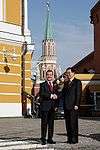













.jpg)